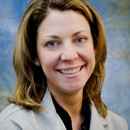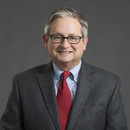The key to a successful sim center, Sergel and Kremer say, is pedagogy. To get there, says Sergel, the team started with its requirements and worked backward.
“If the goal is to practice resuscitation with good compressions, obviously we don’t want to use a live patient,” says Sergel. “It’s better to use a high-fidelity simulator that can receive the compressions, that can be properly intubated — procedures can be done without harm to a human being.”
Data capture is key to students’ learning, so it was built in to the RCCSS design. Several tools, from sensors in the manikins to AV equipment integrated with Linksys, capture as much information as possible on students’ performance during scenarios. An Epson BrightLink 485Wi interactive projector in the classroom, for example, lets presenters annotate their slides directly during presentations, so students returning to the presentation for study later can see those annotations.
EDTECH: Was there a blueprint you followed to build the center?
Sergel: There’s no real standard per se, but the immersive world of simulation-based education is a growing entity in medical education. There are mistakes that we’ve all made as simulationists in the community of medical education across the country.
The technology tends to attract a lot of attention, but the pedagogy is really important. We all need to have a standard in how we teach and how we debrief in this environment. That’s becoming more and more standardized among the different simulation centers. It’s not a competition; we’re banding together to figure out what best practices are for teaching in this type of medium.
EDTECH: How do you decide what technology to incorporate?
Sergel: We work backward from the objectives and the goals for the learners with the course directors and figure out which form is best for them. For example, if the goal is just to do a procedure over and over again, a task trainer might be helpful.
A task trainer is like a piece of the body used, for example, to put in a central line, or to intubate. We can repeat the action over and over again with proper feedback. RCCSS is also involved in the beta testing of new clinical technologies, such as the voice-activated electronic medical record interface.
Kremer: From a simulation education standpoint, the most meaningful feedback that our students can get is through debriefing.
Sergel: The debriefing processes — that’s the crux of simulation-based education. Putting them through the scenario is one thing, but to talk about it afterward is very important. A lot of times we’ll use technology to record the procedure or scenario that the participants just went through and play it back in the debriefing.
EDTECH: What advice would you give a colleague about to embark on a similar project?
Kremer: In the big scheme of things, it probably costs more to retrofit an old space than to create a new space. The space we occupy is in a couple of buildings that were both built over 60 years ago.
There were unexpected findings that made the demolition process a bit more complex. We also have multiple different HVAC systems for the whole 20,000 square feet, and they don’t communicate; that can be challenging in terms of trying to achieve any sort of climate control.











